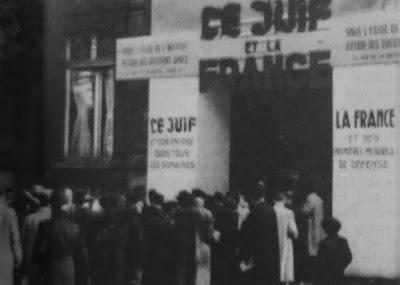 Bordeaux’s wartime history remains an opaque affair. Throughout that dark period, the city was the scene of many events, some of which were of huge strategic significance, some proved dramatic, others inspirational, while others stand out as particularly unsavoury when viewed from a 21st-century vantage point. One such example of the latter is an exhibition entitled “Le Juif et la France” hosted at the city hall over six weeks.
Bordeaux’s wartime history remains an opaque affair. Throughout that dark period, the city was the scene of many events, some of which were of huge strategic significance, some proved dramatic, others inspirational, while others stand out as particularly unsavoury when viewed from a 21st-century vantage point. One such example of the latter is an exhibition entitled “Le Juif et la France” hosted at the city hall over six weeks. 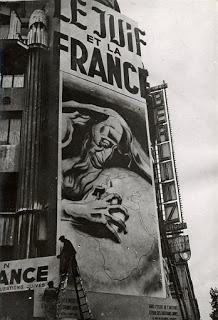
Outside the Palais Berlitz event in Paris,
photo source: www.cndp.fr
To gain widespread public support among France’s non-Jewish population, the regime resorted to various propaganda drives that victimised Jews. These initiatives included the Le Juif et la France exhibition which was first held at Palais Berlitz on the boulevards in Paris from September 5th 1941 to January 15th 1942. The exhibition was organised by IEQJ, the Institut d’Études des Questions Juives, a body which was financed by the German embassy in France and overseen by Nazi security and propaganda services.
The exhibition sought to highlight the stronghold that Jews had secured within institutions and economic sectors throughout France. In addition, to help citizens become more effective in recognising the “enemy”, the exhibition provided a beginners’ guide to the physical features of Jews. It also went beyond these stereotypes to point fingers at emblematic individuals who were showcased on large panels, such as the furniture seller Wolff Lévitan, radio journalist Jean-Michel Grunebaum, playwright Henri Bernstein and the politician Léon Blum.
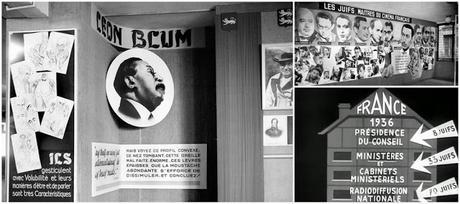
Some of the displays from the Paris leg of the exhibition, picture sources:
aufildelhistoire.u.a.f.unblog.fr, parisenimages.fr and voir-et-transmettre.fr
Significantly, the Bordeaux event was held in a wing within the grounds of the city hall, where the Musée des Beaux-Arts can now be found. The building had already served a similar purpose in May 1941, when it hosted an exhibition entitled “L’Allemagne de nos jours”, aimed at raising awareness about German culture and industry, its centerpiece being a bust of Adolf Hitler surrounded by a colourful hydrangea bed.
The Bordeaux leg of the Juif et la France exhibition opened on March 28th 1942 and ran for six weeks until May 11th (the Nancy event later stretched from July 4th to August 2nd). Again, it is difficult to establish reliable attendance figures but it is thought that over 60,000 viewed the exhibition in Bordeaux, including children from all local schools. The IEQJ's short-lived official publication, Le Cahier Jaune, later saluted the figure, equating it to 20% of the 300,000 living in and around Bordeaux at the time.
Along with the static exhibits, a makeshift cinema was set up under canvas in the gardens of the hôtel de ville, showing films including “Le Péril Juif” and “Les Corrupteurs”, and no less than three conferences were held each week.
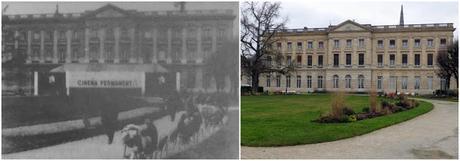
The "cinéma permanent" and the same scene today.

The entrance to the exhibition (as also pictured in the lead photo at the top of the article), and the view today.
Reporting on the exhibition, local newspaper La Petite Gironde (whose allegiances lay firmly with German forces) related that those “forty days sufficed for our fellow citizens to take stock of the Jewish threat. In criminal enquiries it was hitherto customary to seek out the implication of a woman. We now know that when studying the causes of all misery, bankruptcy, financial disasters, scandals and war, we have to seek out the Jews”. Whether the message taken home by the people of Bordeaux was that clear-cut cannot easily be established, but the exhibition undeniably contributed to the climate that ultimately resulted in hundreds of Bordeaux Jews being rounded up and deported over the following months.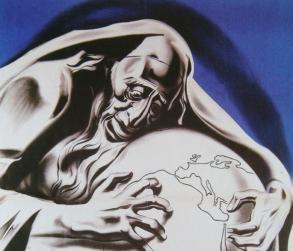
A closer look at the disturbing illustration that promoted
the exhibition. Source: http://paril.crdp.ac-caen.fr
In this instance, as so often when relating these wartime tales, what went on seems to be the unbelievable end-product of some unrecognisable parallel universe. And yet the setting is so familiar and so recent that it makes for chillingly painful reading. Then again, perhaps we need more stark reminders of these past events right now…
This "Actualités Mondiales" clip reports on the exhibition in Paris: Click here if video doesn't display properly on your device. > The authoritative biography of Adrien Marquet referred to further up the page is Adrien Marquet, les dérives d'une ambition by Hubert Bonin, Bernard Lachaise and Françoise Taliano Des Garets.
> Further reading:
- https://www.histoire-image.org/etudes/exposition-juif-france-paris
- http://www.gauchemip.org/spip.php?article8812
- http://rue89bordeaux.com/2015/05/13-mai-44-dernier-convoi-bordeaux-auschwitz/
> Photos from the Bordeaux event extracted from report in IEQJ publication Le Cahier Jaune, archived by the Centre de documentation juive contemporaine (report featured in Adrien Marquet, les dérives d'une ambition).
